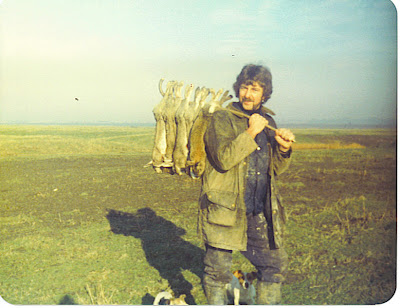
This morning saw a repeat of yesterday with me being on the seawall in the dark, pre-dawn. The only differences were that clock-wise, I was an hour earlier, and today post-dawn was not all clear blues skies and sunshine, it was very gloomy and eventually turned to steady rain around 07.30.
I love walking across the marsh in the dark, it has a Dickensian feel about it, especially when its damp and murky like today pre-dawn. Today there were more birds getting up in front of me in the dark, I disturbed a few Golden Plovers, Redshanks and the odd Skylark and never saw any of them as they disappeared in the dark, calling as they went. I imagine that wandering across the marsh in the dark like that would be quite daunting to someone doing it for the first time and it does pay to have a good sense of direction (for when its foggy) and where the various ditch crossing points are. Years ago on most marshes there always used to be a network of crossing planks across most ditches that you quickly memorised and made for, they were vital in order to avoid having to walk the long way round lengthy ditches. Nowadays, with most farmers and stockmen prefering to do their livestock "looks" from the insides of a 4x4, these crossing points have been left to rot away or removed.
On top of the seawall in the dark I looked out to The Swale and watched a small yacht making its way out to the open sea, its red, mast-top light like some firefly gliding through the darkness. Soon the yacht was overtaken by a fishing boat with its diesel engines throbbing across the saltings towards me, the sea beginning to come to life, even in the dark.
The speed at which the light suddenly begins to take over always amazes me, at first the merest lightning of a patch of cloud above you, then more and more patches, then distance starts to increase and objects begin to take shape. What I had thought was the dark head of a wildfowler sticking up from a saltings gulley turned out to be a clump of Sea Aster, the bright lights on buildings across on the mainland began to fade into the gloomy dawn light and crows began to appear as they made their way back to Harty from their mainland roosts.
Two Little Egrets silently made their way past over the saltings in front of me, like miniature ghosts, then another two and yet another two, they seem to prefer to be in pairs for some reason.
I could now see about a mile in front of me so time to wander along the seawall for a while, accompanied by the non-stop chorus of Curlews out on the mudflats and the sounds from another fishing boat making its way out to the open sea. This time, two dark shapes did turn out to be two wildfowlers out on the saltings, the same two as yesterday, but with no wildfowl being seen at all they never fired a shot for the two hours that I was out there. Quite clearly it was going to remain gloomy, light-wise this visit and to emphasise that point, at 07.00 it started to spit with rain and so I turned off the seawall and begun to make my way back across another part of the reserve. A few Skylarks passed by overhead, probably incoming migrants, then some Goldfinches and a couple of Greenfinches alighted on some nearby teasel heads with much twittering and activity before carrying on to wherever they were going.
The rain had settled in to become quite steady by then and stood for a while and wistfully watched the drops falling into the shallow waters of a ditch and pondered the fact that tomorrow we start November with water levels lower than they were in July. One long-range forecast this week suggested a mild and dryer winter to come, hopefully the dryer bit won't come true, we do need a lot more rain to make the reserve live up to it's wetland reserve status. I recall that at the beginning of the 1990's we had two dry summers with a dry winter in between and it was disastrous habitat and wildlife-wise.
Waking from those ditch-side ponderings I realised that I was getting increasingly wetter and so decided that an early return home was in order and so made my way through the lovely Devon cattle and back to the car.
RECEPTION COMMITTEE (notice the Tower Hide in the background)





















